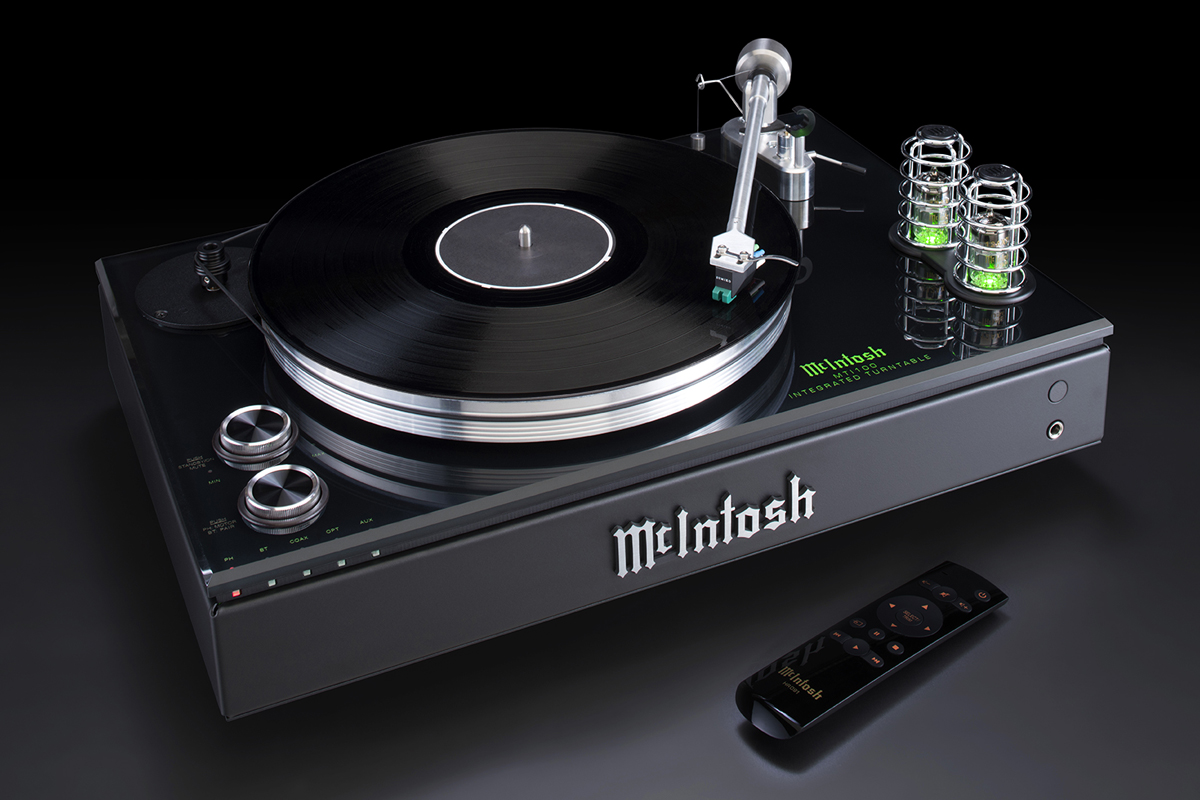When most people think of audio components from McIntosh Laboratory, they think of serious high-end separates: preamps and big, powerful amplifiers. But there’s another side to this iconic brand, which this year celebrates its 70th anniversary. McIntosh now offers several lifestyle audio products, including integrated music systems, streamers, headphone amplifiers, and the subject of this review: what they call an integrated turntable.
In one gorgeous package, the MTI100 ($6500; all prices USD) combines a turntable, tonearm, preinstalled cartridge, phono stage, tube preamplifier, class-D power amp, Bluetooth receiver, and headphone amplifier. Just add speakers or headphones and you’re ready to play.
Like all McIntosh products, the MTI100 oozes class and luxury. While it lacks the brand’s iconic blue power meters, the MTI100 has other McIntosh retro design cues. The color black predominates, with accents of matte silver and iridescent green. The front and side panels are matte black, with a raised-metal McIntosh logo in large gothic type front and center. The top deck, on which the turntable sits, is a 3/8”-thick pane of the same glass used for the front panel of McIntosh amps, over a 1/4”-thick plate of black aluminum. This construction provides a solid foundation for the turntable, McIntosh says. The platter and tonearm, both of cast aluminum, dramatically contrast with the gloss-black deck, which sports a McIntosh logo that lights up green when the MTI100 is turned on.
In the front left corner of the deck are two flattish knobs: the rear one is used to adjust volume, the front one to select sources. The selected source is indicated by one of a row of five LEDs along the top left edge of the front panel. At the center of the volume knob is a pushbutton for toggling the entire MTI100 between standby and on. The pushbutton at the center of the source knob powers up the turntable’s motor.
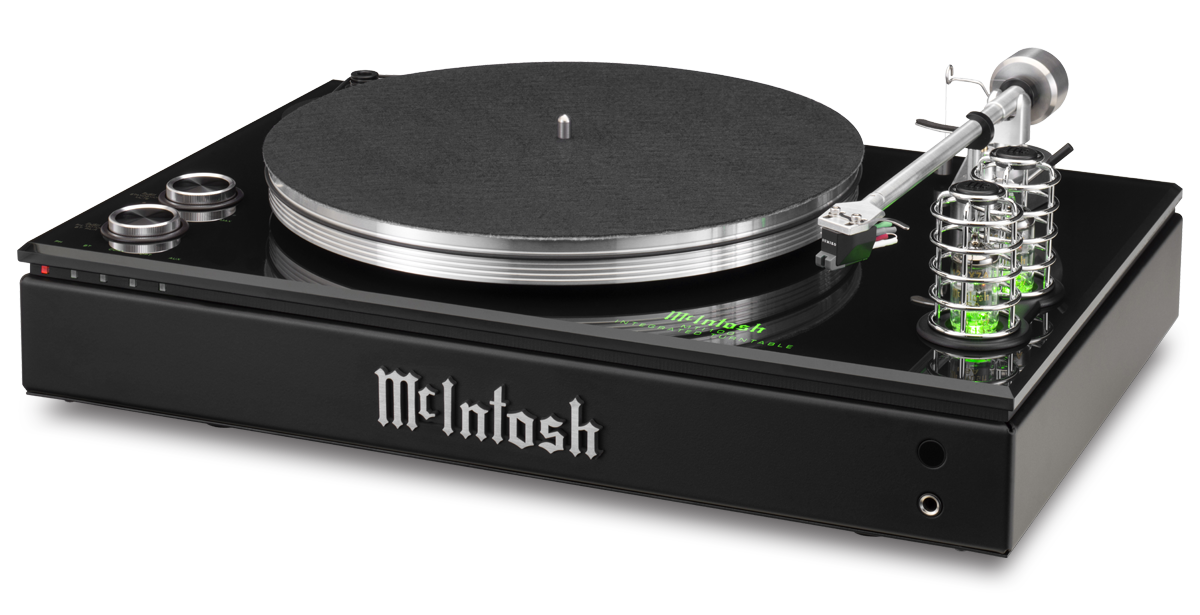
In the right front corner of the deck are two vacuum tubes in metal cages. When the MTI100 is powered on, the tubes are lit from below by LEDs whose green matches the illuminated McIntosh logo, and complements the warm orange of the tubes’ glowing heater filaments. The result is a bit of steampunk vibe that makes the MTI100 look edgier than most McIntosh models.
No review product I’ve had in my home has elicited more oohs and ahs than the MTI100. Judging by my guests’ reactions, I’m sure there will be people who see the MTI100 and will just have to buy it. But before handing over their plastic, most prospective purchasers will want to know how the MTI100 performs. Does McIntosh’s integrated turntable live up to its distinguished logo?
Inside and out
Out of the box, the MTI100 can play music from its built-in turntable and paired Bluetooth devices. There are also jacks on the back for connecting other components. In addition to TosLink optical and S/PDIF coaxial inputs with maximum resolution of 24-bit/192kHz PCM, there are a pair of RCA line-level inputs and a subwoofer output. Also on the rear panel are: a Bluetooth antenna (misidentified as a Wi-Fi antenna in the otherwise excellent manual); preamp output and power-amp input jacks (joined by supplied jumpers), in case you want to use an external power amp; and speaker terminals that accept spade lugs, banana plugs, and bare wire. Note that the subwoofer output has no low-pass filter -- it delivers full-bandwidth, summed, line-level audio. To set the crossover frequency and level, you’ll have to use your sub’s controls.
On the lower right corner of the front panel is a 1/4” headphone jack. When you plug in a pair of cans, the MTI100’s speaker output is automatically muted.
The plastic remote control supplied with the MTI100 has buttons for volume, mute, source selection, and power, as well as transport keys for controlling a McIntosh CD player.
Measuring 19.25”W x 6.75”H x 14”D and weighing 33.5 pounds, the MTI100 is a substantial piece of kit. Accounting for a significant chunk of its weight is the belt-drive turntable, parts of which are sourced from VPI. The ’table’s seven-pound platter rotates on an oil-bath bearing with a thrust pad of super-hard polyetheretherketone (PEEK) and graphite-impregnated brass bushings, and is driven by a 600rpm AC synchronous motor.
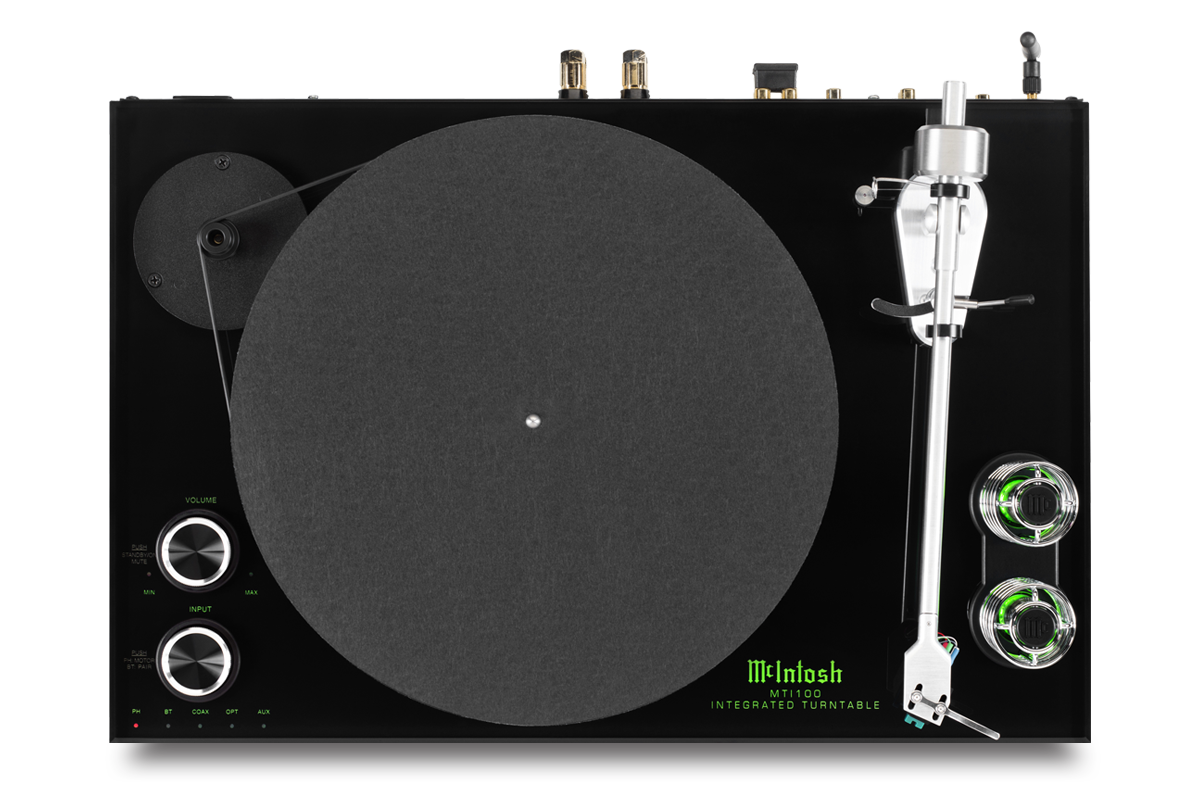
Inside the MTI100, a shielded phono stage feeds a preamp employing those two 12AX7 high-gain triode tubes. Has McIntosh opted for a tubed preamp for reasons of sound quality or appearance? I don’t know, but as I’ve noted, the caged tubes certainly make a visual statement.
Connected speakers are driven by the MTI100’s class-D amplifier, specified to deliver 50Wpc into 8 ohms or 80Wpc into 4 ohms, 20Hz-20kHz. The MTI100’s total harmonic distortion is a highish 0.5% at full output, but falls to 0.2% for any level from 250mW to half rated output. McIntosh doesn’t say what class-D amplifier technology it uses.
Employing the same High Drive design as other current McIntosh products with headphone outputs, the MTI100’s headphone amplifier has a specified output of 340mW into 47 ohms or 150mW into 300 ohms.
Setup
Like any record player, the MTI100 should be installed on a rigid, level surface. Its own footers aren’t adjustable, so you may have to shim one or more of its feet to get it truly level on both axes. I placed the MTI100 on a solid coffee table in the living room of our Toronto home. We had the house renovated just over a year ago, so the floors are level.
Typically, setting up a turntable is a fiddly affair, but that wasn’t the case with the MTI100. It comes with a Sumiko Olympia moving-magnet cartridge (available separately for $199) preinstalled in its tonearm, and the arm’s counterweight is locked in place with a setscrew to provide the recommended 2gm of vertical tracking force (VTF) -- no need to install the cartridge or even balance the arm.
Assembling the MTI100’s ’table requires only that you lower the platter onto the bearing, loop the belt around the platter and the exposed drive pulley that pokes up through the rear-left corner of the top deck, and thread the filament from which hangs the little antiskating weight through the eyelet and shaft attached to the arm pivot. This is as close to plug-and-play as vinyl gets. The pulley has two grooves -- the smaller, upper one for 331⁄3rpm playback, and the larger, lower one for 45rpm. To change speeds, you manually move the belt from pulley to pulley.
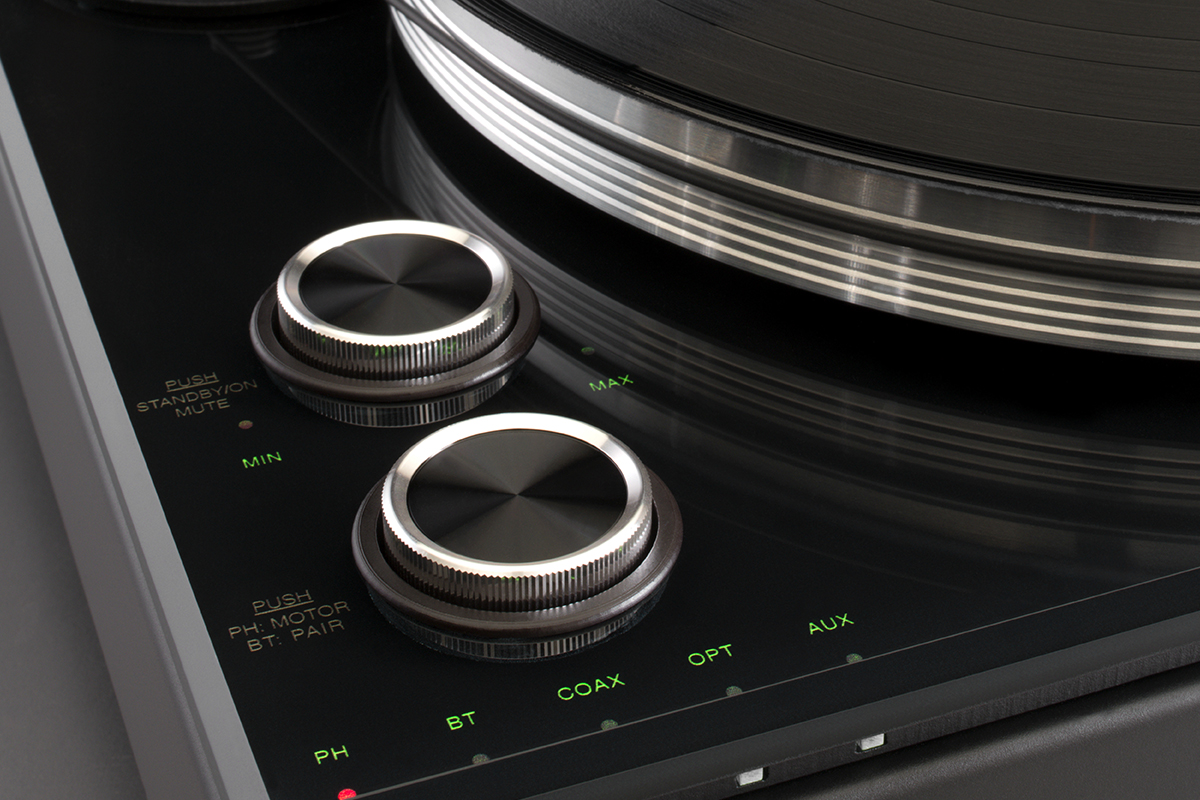
You also have to insert the two tubes in their sockets, then lower into place their protective metal cages. This process was completely straightforward except for one thing: I couldn’t extract one tube from its plastic foam packaging -- it was stuck. I carefully pried the layered foam apart and, from the bottom, pushed the tube up and out.
With a 10’ pair of AudioQuest 44SBW single-biwire speaker cables, I connected the MTI100 to a pair of Totem Acoustic Sky Tower floorstanders ($2250/pair), which Philip Beaudette reviewed last November for our sister site SoundStage! Hi-Fi. Each two-way Sky Tower houses a 1.3” fabric-dome tweeter and 5.75” woofer, connected by a simple first-order crossover. The Totem’s specified sensitivity of 88dB/W/m, and a nominal impedance that remains above 8 ohms throughout the audioband, make it an easy load to drive.
I also used my HiFiMan Edition X V2 planar-magnetic headphones ($1299), whose impedance of 25 ohms and sensitivity of 103dB make it another easy load.
Listening in analog
Before moving into our current, smaller home, I’d got back into analog after three decades of listening only to digital. But downsizing meant that I had to sell my Pro-Ject 2Xperience turntable and all my vinyl. For this review, I borrowed several LPs from my sister and brother-in-law, and bought a few more from a local used-record store.
One of the LPs I bought was a Canadian pressing of Carl Orff’s secular cantata Carmina Burana, in a classic 1965 performance by the New Philharmonia Orchestra and Chorus under Rafael Frühbeck de Burgos (Angel 36333). Composed in the early 1930s, this huge work is scored for full orchestra and two pianos, chorus, boys’ choir, and four solo singers. I suspect that most music lovers, whether or not they listen to classical, will immediately recognize the dramatic opening section, “O Fortuna.”
The MTI100 needed a little warm-up to sound its best. When I first played “O Fortuna,” the sound was a little brash, especially at high volumes. But this harshness dissipated as the work progressed, and after 15 minutes I moved the tonearm back to the beginning of the side. “O Fortuna” now sounded smoother, more transparent -- the hardness wasn’t gone, but it was markedly reduced.
Substituting a 2m-long Wireworld Stratus 7 power cord ($120) for the MTI100’s stock cord also improved the sound. There was less grunge and glare, and a significant increase in dynamic headroom -- peaks were less compressed -- but loud passages still sounded somewhat congested.
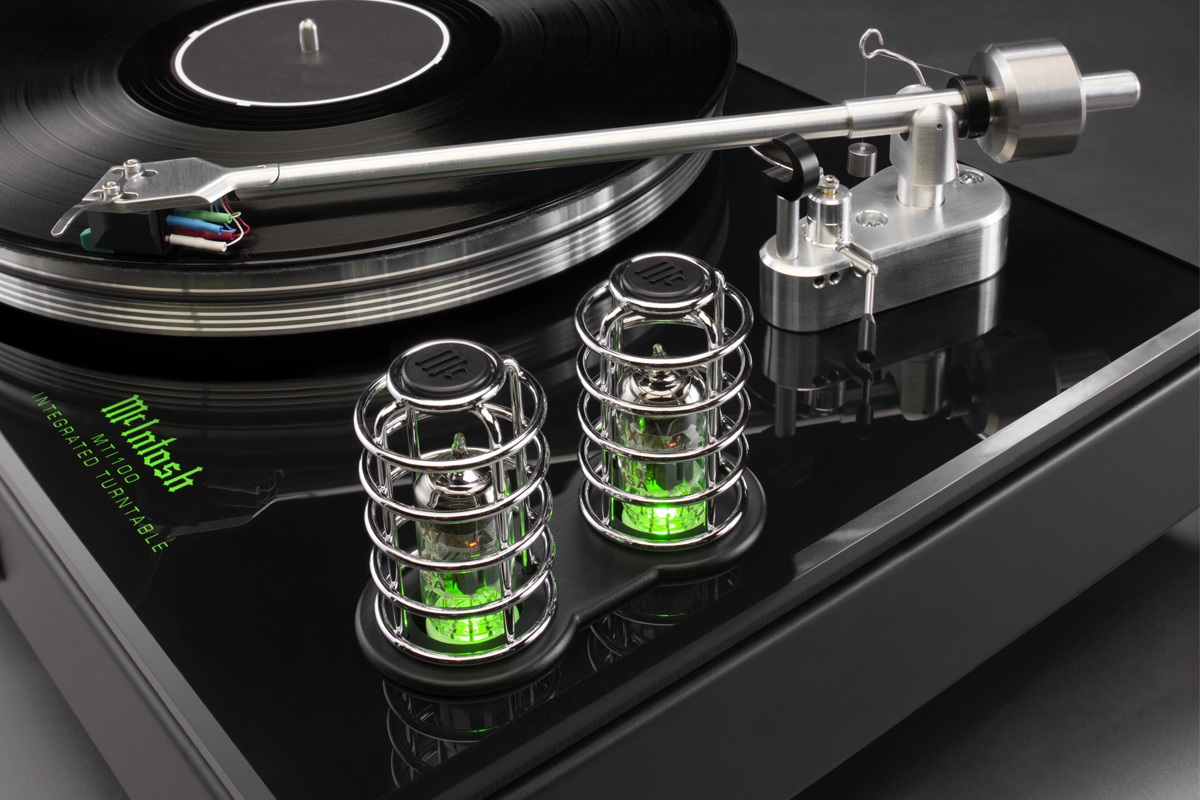
Otherwise, the sound was terrific. Soundstaging was outstanding, especially in passages for antiphonal choruses. Quieter choral and orchestral passages were wonderfully transparent and beautifully layered. What was especially impressive was the size of the musical forces and the recording venue, EMI’s famous Abbey Road Studio No.1 -- huge. Not only did this create a convincing facsimile of a live performance, it helped me appreciate how a composer can use space to create a soundscape. The sound of Lucia Popp’s soprano in her solos was exquisite, and the pianos and other percussion had impressive weight and authority.
Similarly, I was wowed by the huge spatial presentation of “Gotta Serve Somebody,” from Bob Dylan’s Slow Train Coming (Columbia 36120), the soundstage extending way beyond and behind the speaker plane. Equally striking was how the MTI100 tracked sudden dynamic shifts, such as the rapid swells in Dylan’s snarling, slightly unhinged delivery. However, the sound became a little hard during peaks.
One of the LPs I’d borrowed was Glenn Gould’s 1981 recording of J.S. Bach’s Goldberg Variations (CBS Masterworks IM 37779). In many sections, including the opening Aria, Gould plays more slowly and contemplatively than in his first, 1955 recording of the Goldbergs, which launched his career. His eccentric humming of course is present, but more important, so is his incredibly precise delivery, almost harpsichord-like in its crispness.
The MTI100 and Sky Towers beautifully delineated each note of Gould’s rapid runs. His staccato attacks were delivered with lightning speed, notably in the transition from the Aria to Variation 1, which exploded with joy and energy. However, I still found the piano tone a little hard.
The record, though probably several decades old, was in pretty good shape, without serious scratches but with a fair bit of surface noise. In my experience, a good vinyl setup can dissociate surface flaws from the audio signal, making it easier for the listener to tune out the noise and focus on the music, and I was able to do this with the MTI100. The McIntosh also seemed immune to other ills that can plague vinyl playback: Throughout my listening, I was never bothered by mistracking, or mechanical disturbances from footfalls.
Listening in digital
While its turntable is the MTI100’s dominant visual feature, I suspect that most owners will log more listening time with its Bluetooth connection. Out of the box, the MTI100 is in discovery mode. To pair my LG G7 ThinQ smartphone with the MTI100, I chose the Bluetooth function in the phone’s Settings menu, pressed the looped-arrow icon to refresh the list of available Bluetooth connections, then chose the MTI100 from that list. Easy-peasy. A mild annoyance was that phone sounds such as clicks and alerts were played through the MTI100 when I used a Bluetooth connection.
The MTI100 supports advanced Bluetooth codecs, including aptX HD. If your phone has this capability, you’ll have to activate it in the phone’s Bluetooth menus. In my phone’s Bluetooth menu, I tapped the little gear icon next to the MTI100; then, in the Connection Type menu that followed, I chose Best sound quality.
The MTI100 lacks Wi-Fi or network-streaming capability, but you can connect an outboard streamer (from McIntosh or another manufacturer) to one of its digital or analog inputs. While Bluetooth streaming is certainly convenient, there are sonic advantages to streaming via Wi-Fi (see below).
Streamed via Bluetooth aptX HD from my LG smartphone to the MTI100, “Re-Melt,” from the Tord Gustavsen Trio’s The Other Side (24-bit/96kHz FLAC, ECM/Qobuz), sounded lovely. Gustavsen and his bassist and drummer can groove and swing, but they’re also wonderfully deft players. This album has a spiritual, contemplative quality, and the MTI100 and Sky Towers really communicated this aspect of their music-making. Gustavsen’s piano tone sounded fast and articulate, with good sparkle up top and satisfying heft in the lower octaves, but it got a bit clangy when Gustavsen ramped up the volume. Sigurd Hole’s double bass had really good snap and depth. Soundstaging was very good, with satisfying left/right spread, depth, and imaging specificity. However, the sound was flatter, less lively than I remembered.
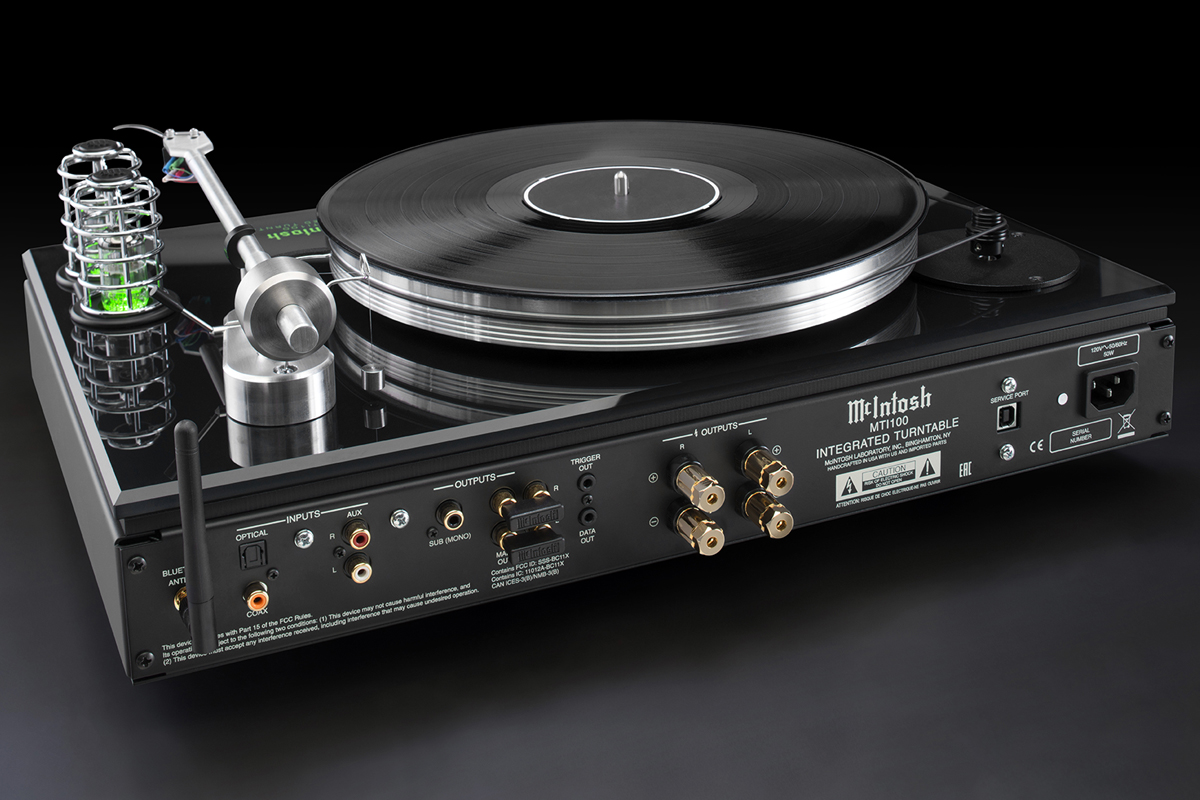
As it turned out, this had more to do with the Bluetooth connection than with the MTI100 itself. Even with aptX HD, the 24/96 Qobuz stream was being downsampled to 24/48, then subjected to 4:1 lossy compression before being sent wirelessly from smartphone to MTI100. Was my aural memory correct? Was there more in this high-resolution recording than I was hearing via Bluetooth?
To find out, I connected the S/PDIF output of my Bluesound Node 2i streaming preamp ($399) to the MTI100’s S/PDIF input using a 2m-long AudioQuest Carbon coaxial interconnect, then played the same album. There was a significant improvement in weight and substance. Gustavsen’s piano tone had greater heft and authority, and the clangy quality was gone. Hole’s bass had more body yet sounded taut and tactile, and Jarle Vespestad’s drumming had more snap. The sound was bigger, more three-dimensional.
Could the MTI100 party? I cued up a raucous, high-energy dance number, “Would I Lie to You?,” from a 2018 remastering of the Eurythmics’ 1985 album Be Yourself Tonight (24/96 FLAC, Sony Music/Qobuz). The opening drum riff just exploded out of the Sky Towers, but when the horns entered, the sound became compressed and harsh. This is a brash, wall-of-sound recording, and via Bluetooth the MTI100 emphasized that quality a little too much for my liking.
When I streamed the same track in 24/96 via Wi-Fi to the Bluesound Node 2i, then via S/PDIF to the MTI100, the sound was more substantial. Every sonic object in that big wall of sound stood out more clearly. The delineation of space improved, with guitars, drums, horns, and backing singers each occupying a specific space on a huge soundstage, and Annie Lennox front and center, belting out this fantastic song.
Listening to the same track through my HiFiMan Edition X V2 headphones, again streamed from the Bluesound Node 2i, confirmed for me the virtues of the MTI100’s High Drive headphone amp. The brashness was there, but driven by the MTI100, the Edition X V2s presented this track’s many elements -- pounding drums, horn riffs, backing singers, synth, Lennox’s voice -- in a pulsating mass of sound.
Turning to something more tender, I streamed “My Right Eye,” from Laurie Anderson’s Homeland (16/44.1 FLAC, Nonesuch/Tidal), from the Node 2i to the MTI100, and listened through the Edition X V2s. Powered by the MTI100’s High Drive headphone circuit, the planar-magnetic ’phones conveyed every expressive nuance of Anderson’s delivery -- sadness, compassion, resignation -- and provided lovely delineation of the instrumental accompaniment.
Comparisons
McIntosh’s MTI100 integrated turntable is unique, which makes comparisons difficult. There are other turntables with built-in amplifiers on the market, but nothing at this level. I would have liked to compare the MTI00 with an integrated amplifier and turntable whose combined cost is in the same range, but I had no access to such a combination during the review period.
However, I was able to compare the MTI100’s amplifier with another amp I’d recently reviewed for Simplifi -- the NAD Masters M10 BluOS streaming amplifier ($2500), which received a Reviewers’ Choice award. The M10 is specced to output 100Wpc into 4 or 8 ohms (20Hz-20kHz, 0.03% THD, both channels driven). This isn’t just an apples-and-oranges comparison. Given the differences in feature sets, it’s more like apples and kumquats. Nonetheless, what I heard was instructive.
Streaming the Eurhythmics’ “Would I Lie to You?” to the NAD M10, and to the Bluesound Node 2i connected to the MTI100, I found the sound less harsh through the NAD. While the M10 reproduced this high-energy track with a greater sense of ease, the sound wasn’t as big as the MTI100. A coin toss.
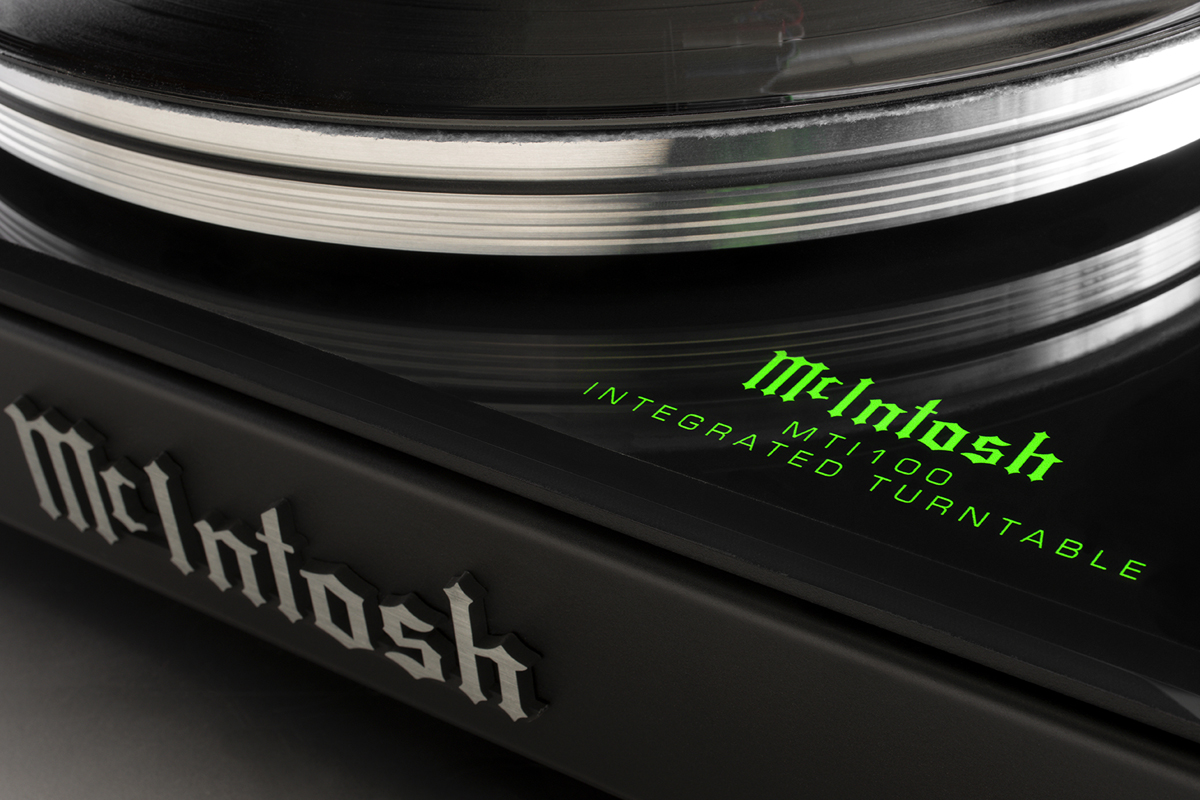
The title track of the Charles Lloyd Quartet’s Passin’ Thru (24/96 FLAC, Blue Note/ProStudioMasters) opens with a snappy bass solo by Reuben Rogers, after which drummer Eric Harland enters with rim shots and cymbals. Then pianist Jason Moran joins in, followed by Lloyd on alto saxophone. It all sounded big and fast through the MTI100, but with some hardness when the band really got going. Through the NAD M10, Harland’s rim shots didn’t have as much snap as through the MTI100, but they did have more body. Rogers’s bass sounded richer and woodier through the M10, Moran’s piano bigger and more authoritative. However, the MTI100 created a larger soundstage, which was really suitable for this album, recorded live at the Montreux Jazz Festival and at the Lensic Performing Arts Center, in Santa Fe, New Mexico.
For headphone sound, I conducted another apples-and-kumquats exercise, comparing the MTI100’s headphone output with my iFi iDSD Micro BL DAC-headphone amp ($599), connected via USB to my MacBook Pro laptop computer. In its Normal power mode, the setting I used, the iDSD Micro BL has a specified output of 950mW into 32 ohms or 100mW into 300 ohms.
In “My Right Eye,” Anderson’s voice sounded slightly more embodied and substantial through the iFi amp, but expressive nuances were clearer through the MTI100. For this track, I preferred the MTI100 by a slight margin. But the iFi played the Eurythmics’ “Would I Lie to You?” with a greater sense of ease. In the dense middle portion of that song, the sound was a little less congested and less harsh.
Conclusion
From all of this listening some common themes emerged. As noted, the MTI100 could sound a bit harsh when driven hard, but that’s not the quality that stood out for me. Throughout the review period, I was wowed by the MTI100’s transparency and big, spacious sound -- it made listening to music an event. I also admired how McIntosh has conceived and executed this product. I can’t imagine easier setup.
I have a couple of suggestions for prospective purchasers. While it’s easy and convenient to stream from a mobile phone via Bluetooth, people who use streaming services heavily, or have large collections of downloaded and ripped music files, should consider adding an outboard streamer. A power-cord upgrade would also be worth the investment.
As happens far too often these days, the announcement of the MTI100 in January brought out the trolls on Internet forums. The more informed commenters opined that buyers could get better sound from a separate amp, turntable, and cartridge. These people may have a point, but they’re also missing one. The MTI100 isn’t aimed at hardcore audiophiles, but at listeners who want a simple, stylish way to enjoy music in a real-world listening space. At that, the MTI100 succeeds in spades.
To me, such comments betray a failure of imagination -- an inability to conceive that other people’s tastes and priorities might differ from one’s own. McIntosh Laboratory’s MTI100 is an audio component, but it’s also a piece of industrial art. People will want it for what it is as much as for what it does. If you’re one of these people, but want to know if the MTI100 can also deliver the sonic goods before you hand over that plastic, I have the answer: Yes, it can. Go for it.
. . . Gordon Brockhouse
Associated Equipment
- Speakers -- Totem Acoustic Sky Tower
- Sources -- Apple MacBook Pro laptop computer running Audirvana 3.2.16, Bluesound Node 2i streamer, LG G7 ThinQ smartphone
- Speaker cables -- AudioQuest 10’ 44SBW Rocket (single biwire)
- Interconnect -- AudioQuest Carbon (coaxial)
- Power cord -- Wireworld Stratus 7 (2m)
- Headphones -- HiFiMan Edition X V2
- DAC-headphone amplifier -- iFi iDSD Micro BL
McIntosh Laboratory MTI100 Integrated Turntable
Price: $6500 USD.
Warranty: Three years parts and labor.
McIntosh Laboratory, Inc.
2 Chambers Street
Binghamton, NY 13903
Phone: (607) 723-1545
Fax: (607) 724-0549
Website: www.mcintoshlabs.com



